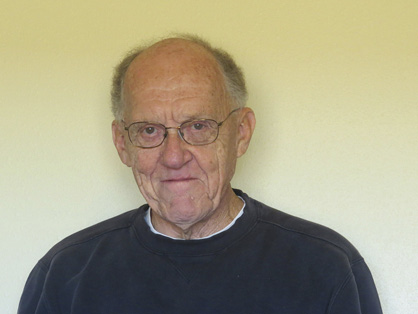On Wednesdays, when Shirley Springer’s dad closed the front door of the drugstore in Garwin, Iowa, at midnight and turned off the lights, Shirley went across to the Bowery, an open air pavilion, and danced ‘til one in the morning. When Kenny Hofer and the Midwesterners were playing, as many as 700 people paid 75 cents to go through the swinging gate to the dance floor. A bandshell held the band and seats ringed the floor with a short fence surrounding it all.
Crowds of people stood around the outside looking in or sat in their cars to listen. Some brought the car earlier in the day to get a parking place. “The whole Main Street and all around was so full you couldn’t find a place to park,” said Marley Bacon. “They’d be parked two rows, one behind the other.”
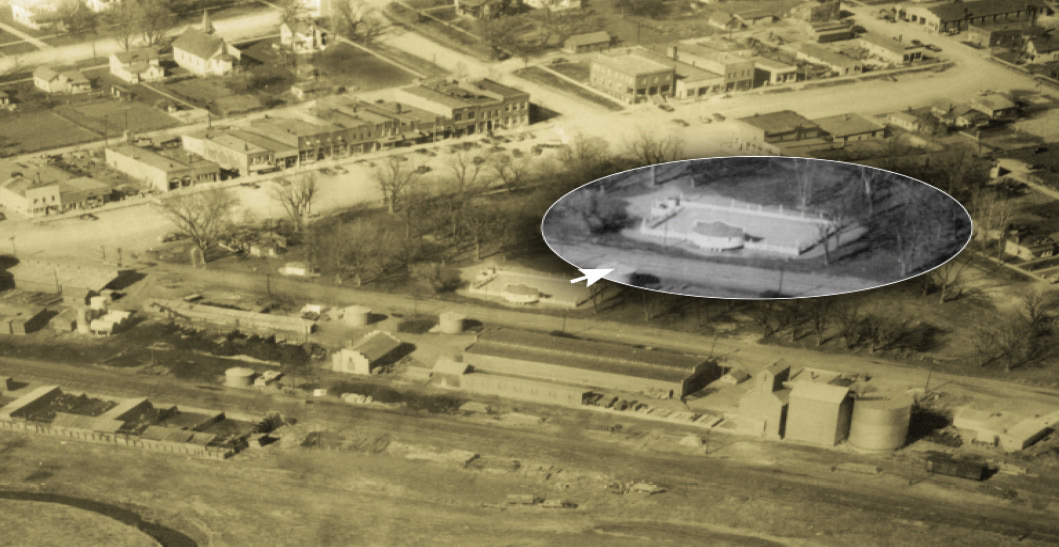
The Garwin Bowery, Photo courtesy of Frank Heath
Wednesday night in Garwin was business, of course, with grocery stores open late as farmers brought eggs and cream to sell, but the 8 p.m. free talent show and the dance from 9 p.m. to 1 a.m. provided entertainment, and the chance to two-step, foxtrot, waltz, or round dance. There was an intermission at 11 p.m., and the bars and the drugstore did steady business. Then the dancers came back.
“The floor was crowded,” Shirley said. “They’d put cornstarch around to make it slippery. Everybody danced.”
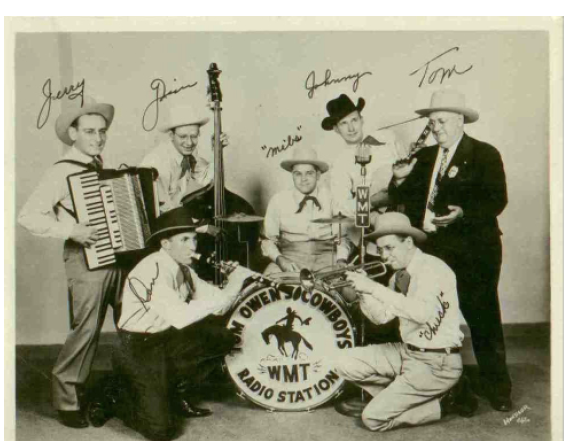
Tom Owens and His Cowboys, Photo courtesy of Frank Heath
Burdell Aldrich said he and his wife danced at the Bowery—the two-step and the waltz. “The waltz is a wonderful dance. And my wife, she didn’t want to leave ‘til the last dance was over.”
Many bands played at the Bowery through the ‘30s, ‘40s, ‘50s and into the ‘60s: Les Hartman, Leo Greco, Tom Owens and His Cowboys from WMT, Don Hoy from Brooklyn, Tiny Hill, Ralph Slade. The Charlie Barnet Orchestra played there, too, probably taking the Wednesday night gig as they traveled between two larger cities.
The names of the bands that played at the Bowery and other area venues bring echoes of the times: Andy’s Ridge Runners, The Salt Creek Syncopators, Rob McClellan and His Gloomchasers, Spider Kurth’s Orchestra, The Moeller Accordion Band, Joe Fisher, Sovereign of Concertinists and his Victor Recording Orchestra, Woody’s Woodchoppers, Burt Whorell and the Night Owls, the Iowa Cornhuskers.
During the ‘30s the Garwin Business Men, acting as a Chamber of Commerce, sponsored the dances in cooperation with the American Legion. The amateur contest at 8 p.m. carried a $10 prize for the winner and a chance to compete for the grand prize later in the summer—an early Garwin version of American Idol.
In 1945, the show before the July dances featured the stars of radio, Ken Houchins, Mary Lou, and Wanda Hargrave from WHO, the Higgins Brothers of KXEL, Happy Haines of WMT with Mary Bernard. WHO also sent Cliff and Helen, Red Scobee and Jack Lester.
By the ‘50s, the Garwin Commercial Club was cordially inviting people to attend. Dallas Wiese and his wife Joyce liked to jitterbug at the Bowery, and Dallas remembers that activities went on outside the fence, too. Someone tossed a firecracker onto the dance floor once, and that occasioned some fisticuffs that week and the next week, too. Workers at the lumberyard across the street spent some of Thursday morning picking up beer cans.
The only thing sold at the Bowery, though, was popcorn. Using two gas burners, ladies started popping corn between 7 and 8 p.m. They turned the handles round and round on the poppers and they did it in shifts until 11 p.m. or midnight. In the early years, the price was a nickel a bag, and they sold $90 to $100 worth. They didn’t sell drinks, but there were two cafes—including one in the old hotel—and two taverns, and the drugstore had a soda fountain. Joan Bacon worked there and recalls learning to make her first Green River, a lime-flavored drink. She also made cherry cokes and vanilla cokes and something called a ‘Suicide Coke,’ a Coke with a dash of every flavor available.
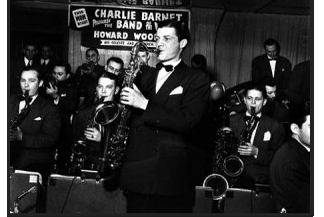
Charlie Barnet Band, Photo courtesy of Frank Health
Other boweries offered the chance to dance. Chelsea had the Vavra Bowery in 1933; Gladbrook had a bowery and Blodgett’s Bowery sat further south, down by the Iowa River. The American Legion had a bowery in Tama. In Brooklyn, it was Landtiser’s Dance Pavilion. Admission there cost 50 cents, and for another dime you could park your car. Many people went to the Forest Park in Marshalltown, and later to the Bricklayer’s Hall in Garwin, but those were inside dance halls.
The Garwin Bowery got a new dance floor in 1949. The Bowery itself lasted into the early 60s, but rock and roll, television, and a changing population brought the crowds and dances to a close. Garwin still has Wednesday events in the summer—music on the bandstand, sandwiches, pie and coffee—but the nights are gone when you held your partner close under the stars and danced to the music of your favorite bands.
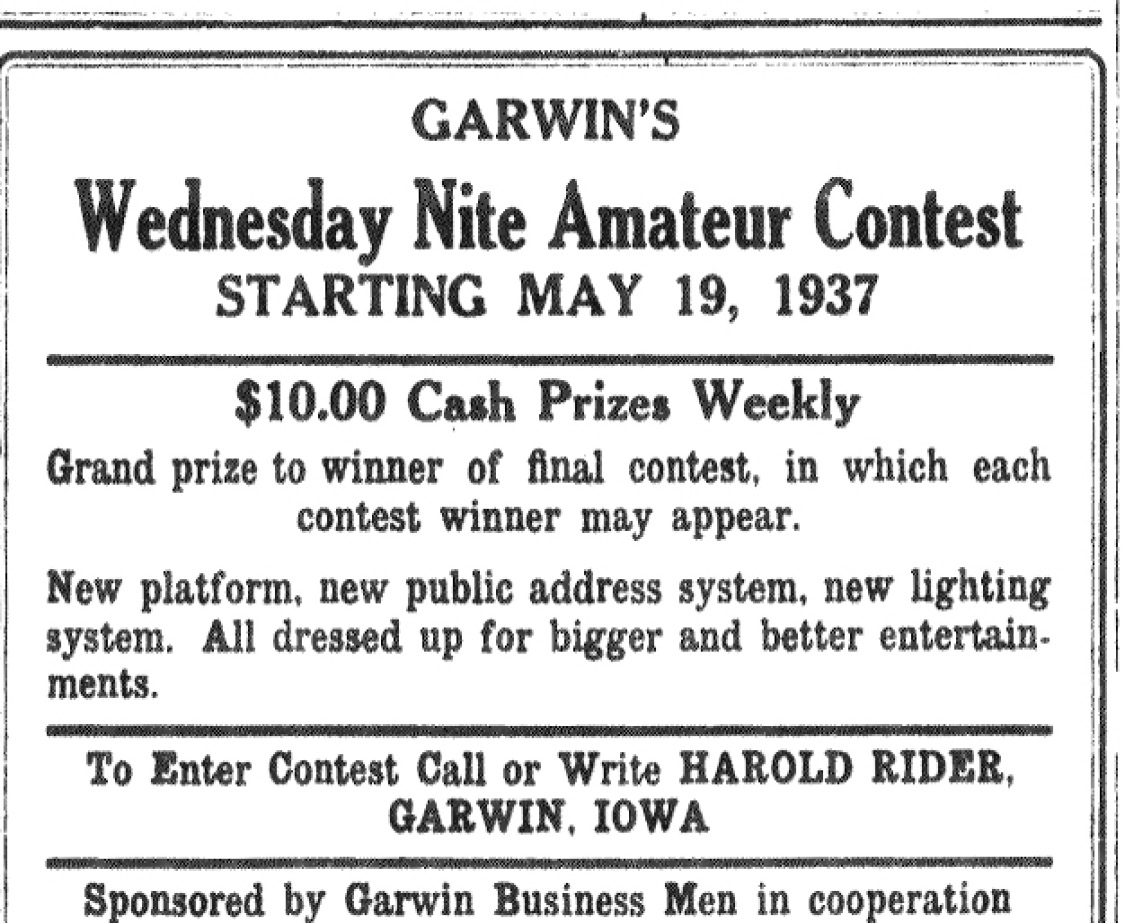
Garwin Bowery Contest, Photo courtesy of Frank Heath


